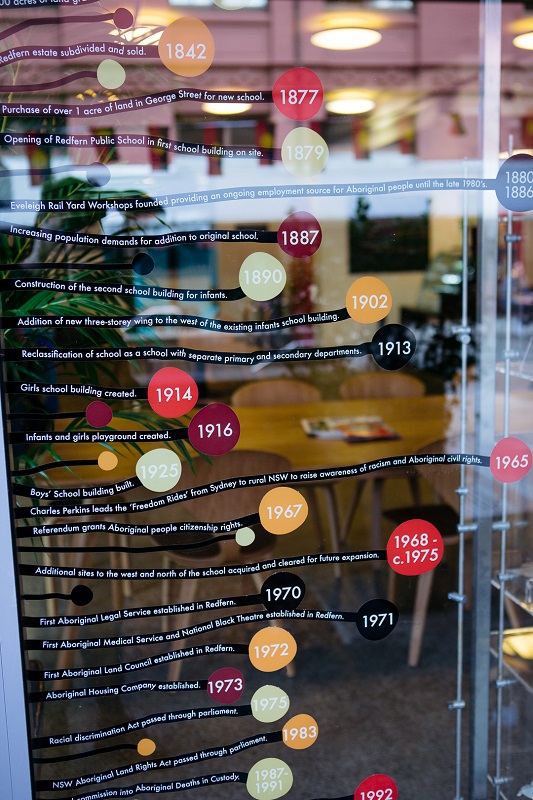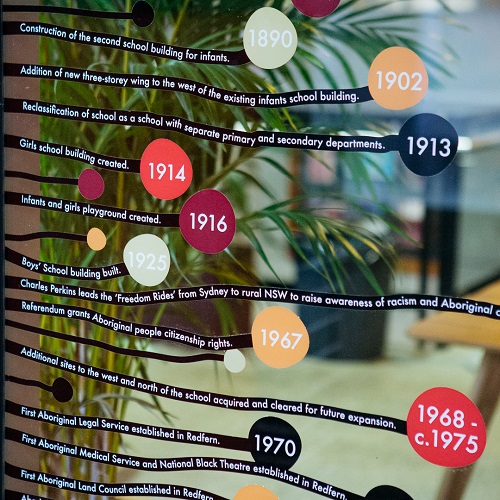Photo: A timeline of the NCIE site and accompanying events on the front window of the NCIE Fitness Centre.
It’s been the school attended by generations of Aboriginal and Torres Strait Islander school students and housed community organisations and events. Now 180 George St Redfern is home to the National Centre of Indigenous Excellence, but keeping with this year’s National Reconciliation Week theme, ‘Don’t Keep History A Mystery’, and prompted by our on-site timeline, we look back on the history of this part of Gadigal country.
Redfern, in inner-city Sydney, holds a special place in the story of contemporary Aboriginal and Torres Strait Islander Australia.
Situated on the traditional lands of the Gadigal people of the Eora nation, Redfern has become synonymous with a large and vibrant local community of Aboriginal and Torres Strait Islander people and a hub of activism and political organisation, arts and creativity.
Redfern was a particular focus for activism around civil and land rights for Aboriginal and Torres Strait Islander people. It has also been the site of many significant milestones in Indigenous community development, health, education, culture and media. The very first Aboriginal legal service, land council, housing company and medical service – all community controlled organisations – emerged in Redfern. And right in the heart of the Redfern community throughout much of its history was the Redfern Public School.
Post 1788
Disease and dispossession followed on from the 1788 invasion, and Aboriginal people were pushed out from the centre of the British settlement at Sydney. 100 acres of land was granted to William Redfern in 1817, which was then eventually subdivided and sold. In 1877, one acre of land in George Street Redfern was purchased for the building of a new school that would become the Redfern Public School, opened in 1879.
As the town of Sydney developed into a city, the Gadigal were joined by other Aboriginal people from around NSW to live, work and forge relationships. At the time the Eveleigh Rail Yard Workshops were drawing large numbers of Indigenous people to the area for work. The quickly growing Indigenous population helped spur the construction of a second school building on the site dedicated to infants in 1890.
1902 saw the addition of a three-storey wing to the west of the existing infant’s school building and in 1913 the school was reclassified as a school with separate primary and secondary departments. In 1914, the girl’s school building was created, followed by the infant’s and girl’s playground in 1916, and the boy’s school building in 1925.
The Great Depression in the 1930’s saw Redfern’s Aboriginal and Torres Strait islander population expand again as our people sought refuge with relatives as work in rural areas became scarce. The outcome of the 1967 Referendum gave Indigenous people unprecedented freedom of movement and many more people came to Sydney for better employment opportunities, housing and education and to reconnect with family.
Then to now
For over one hundred years, Redfern Public School educated generations of Aboriginal and Torres Strait Islander children living in Redfern and surrounding suburbs. Most students knew the school as George Street Public. In 2002, Redfern Public School was closed in controversial inner-city public schools closures. However, this was far from the end of the story for this historic site and its historic buildings.
In 2003, the Murawina Child Care Centre opened in the Infants Building (now Gadigal House) and from 2005 the remaining buildings were utilised by various individual community groups.
In 2006, the site was acquired by the Indigenous Land & Sea Corporation (ILSC). The purpose of the ILSC, a government statutory authority, is to assist Aboriginal and Torres Strait Islander people acquire and manage land to achieve economic, environmental, social and cultural benefits. The old Redfern Public School site was to become the home of the National Centre of Indigenous Excellence as an urban project of the ILSC.
The school buildings were renovated and repurposed into a conference centre with commercial kitchen and dining room, an accommodation block, and offices. A new gym, basketball stadium and swimming pool were constructed on the site and the land at the end of Renwick St was developed into a sports field. NCIE had its official opening in 2010.
Through its services, NCIE aims to build capability and create life-changing opportunities for generations of Aboriginal and Torres Strait Islander people. As a social enterprise we exist to benefit our communities.
Since 2010, NCIE services have directly impacted the lives of 40,000 Aboriginal and Torres Strait Islander people from across Australia through our Fitness and Aquatics Centre, our Conferencing and Accommodation, and our Schools and Job Ready programs. In 2016-17 NCIE Fitness alone contributed more than $350,000 in subsidies and discounts to the Indigenous community.
Our pathway partners, AIME, Tribal Warrior and NASCA also work on the NCIE site.
NCIE’s presence in Redfern – regarded by many as ‘the beating heart of urban Aboriginal Australia’ – honours a legacy of community control while striving towards sustainability in the midst of unprecedented private development in Redfern/Waterloo.
You can check out a timeline of our site and accompanying events on the front window of the NCIE Fitness Centre next time you visit.



